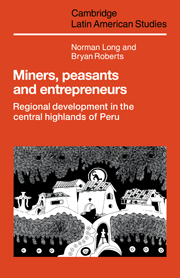Book contents
- Frontmatter
- Contents
- List of tables
- List of figures
- List of maps
- Preface
- 1 Regional development in an export economy
- 2 The development of a regional economy in the central highlands
- 3 The Mining Corporation and regional development
- 4 Class relations, local economies and large-scale mining
- 5 Highland puna communities and the impact of the mining economy
- 6 Migration and social differentiation amongst Mantaro valley peasants
- 7 Industrialization and the emergence of an informal regional economy
- 8 The village economy, agricultural development and contemporary patterns of social differentiation
- 9 Regional commitment among central highlands migrants in Lima
- 10 Confederations of households: extended domestic enterprises in city and country
- 11 Regional development in peripheral economies
- Notes
- Bibliography
- Index
- Titles in the series
11 - Regional development in peripheral economies
Published online by Cambridge University Press: 07 May 2010
- Frontmatter
- Contents
- List of tables
- List of figures
- List of maps
- Preface
- 1 Regional development in an export economy
- 2 The development of a regional economy in the central highlands
- 3 The Mining Corporation and regional development
- 4 Class relations, local economies and large-scale mining
- 5 Highland puna communities and the impact of the mining economy
- 6 Migration and social differentiation amongst Mantaro valley peasants
- 7 Industrialization and the emergence of an informal regional economy
- 8 The village economy, agricultural development and contemporary patterns of social differentiation
- 9 Regional commitment among central highlands migrants in Lima
- 10 Confederations of households: extended domestic enterprises in city and country
- 11 Regional development in peripheral economies
- Notes
- Bibliography
- Index
- Titles in the series
Summary
In this chapter, we aim to place the foregoing accounts within a broader framework of analysis by exploring the usefulness of a regional focus for understanding processes of development in Latin America. In particular, we examine how far the central highlands region has retained its identity and economic vitality in the face of the continuing centralization of the Peruvian economy.
In chapter one, we argued for adopting a production rather than a marketing and exchange approach to regional analysis. From the case materials presented it should now be clear why we chose to do so. The business class of the city of Huancayo did not depend significantly in any historical period upon its ability to control local markets. Its members made little attempt, for example, to monopolize trade in agricultural or craft products. Rather, their main source of wealth derived from the services they provided the mining economy, their investments in enterprises and, to a lesser extent, their monopolies on the sale of imported manufactures. A similar process occurred at village level, since the main source of capital for local entrepreneurship was savings from work in the mining or plantation economy.
Consequently, the development of a periodic market system in the area cannot be interpreted simply as the outcome of widespread and locally based commercial development and a resulting increase in intra-regional specialization. This market system was consolidated in the 1920s and 1930s, with itinerant traders circulating between markets held in different places on different days of the week (Arguedas, 1957).
- Type
- Chapter
- Information
- Miners, Peasants and EntrepreneursRegional Development in the Central Highlands of Peru, pp. 235 - 257Publisher: Cambridge University PressPrint publication year: 1984



